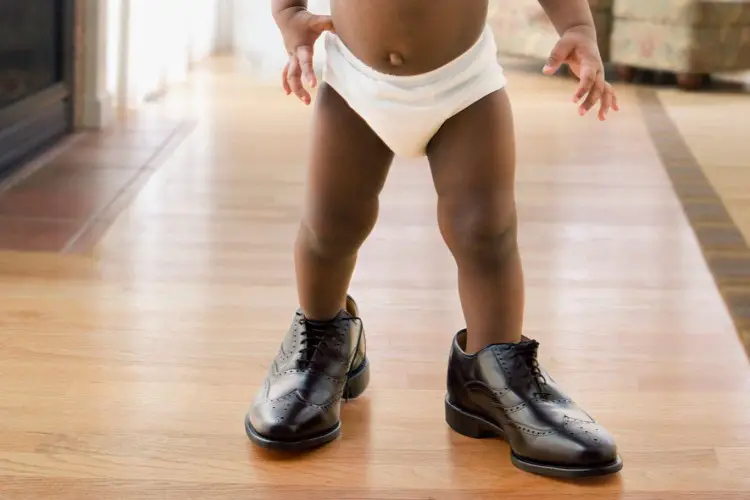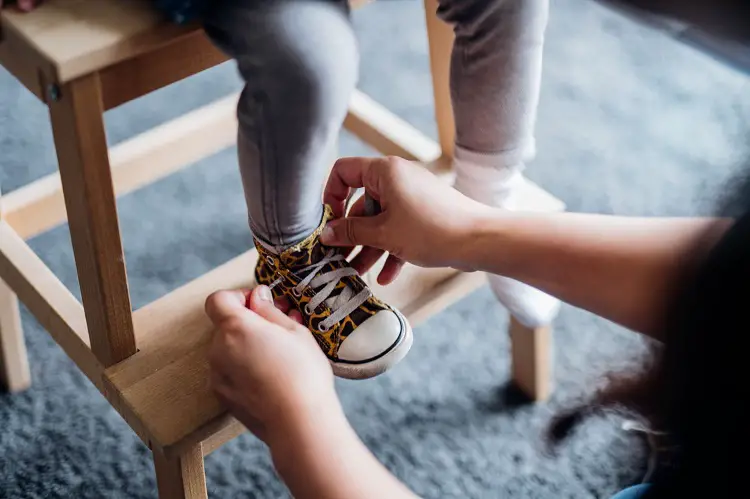Adorning your baby with a nice shoe complimenting their clothing is a good idea.
Are you wondering when should babies start wearing hard bottom shoes? There are many shoes, from tennis shoes to ballet slippers and everything in between.
It is no doubt that shoes make your little one look cute by enhancing their beauty, but the big question is when babies should start wearing hard-bottom shoes.
Babies only need shoes with hard bottoms once they start to walk outside, which is as early as 15 months of age up until 24 months.
This can also happen approximately 6 weeks after your baby confidently walks independently.
What to Look For in Shoes
When choosing a shoe for your little one, you must choose one that is the right size for your baby and always go for one that is flexible.
Ensure that there is plenty of room in the toe box for the baby’s toes and that there is no slipping off the heel.
Even when your baby has gotten to the stage of wearing shoes with hard bottoms, it is necessary that the hard bottom shoe should be lightweight, flexible, and have a solid grip on the ground.
The shoes should “fit snug on the heels and midfoot,” allowing enough room for toes to move.
It would be best to avoid sweaty feet that could lead to blisters. Breathable material is best recommended.
Why Use Shoes on Your Baby?
Your baby taking their first step is a fascinating thing and a joy to behold, but please don’t, out of excitement, give your baby something that will cause problems.
Wait to give your baby shoes until they are walking. Giving your baby shoes is mainly for protection and should be done when walking outdoors.
When you give your baby shoes earlier than it should, know that you are not doing your baby a favor because it wouldn’t even make it learn to walk any faster or better.
Giving your baby hard-bottom shoes makes walking harder for your baby to learn because they restrict natural foot movement.
When Should Babies Start Wearing Hard Bottom Shoes?

The answer is that babies do not need shoes with hard bottoms until they start to walk outside, which is as early as 15 months of age, up until 24 months, and even when they wear it, it should be for a short while.
Some experts believe you should keep hard bottom shoes away until 6 weeks after your baby has started walking independently.
You are asked to wait this long because shoes with hard bottoms are tighter and slightly heavier, making them unsuitable for babies learning to walk.
The flexibility of hard-bottom shoes is lesser than that of soft soles. So it should be used by toddlers that have already started walking confidently.
Until your baby reaches that milestone, do not put on hard bottom shoes on them; if you must put on a shoe on your baby, then go for soft bottom shoes.
Children and Wearing Shoes
Once a baby starts learning how to walk, the soles of their feet touching the ground receives sensory information from the surrounding.
The essence of the footwear your baby is wearing is to help protect your baby’s feet from injury, heat, and cold.
It is necessary that when your baby starts learning how to walk, you should do it on bare feet or a soft-soled shoe. This will help your baby feel what they touch with their feet and develop muscle strength.
You can progress to a hard bottom shoe once your toddler starts being confident in walking over some time.
Only give your baby shoes that are tight enough, as they can hamper your child’s walking.
Barefoot vs Shoe Wearing
It is highly beneficial for your toddler to be barefoot as they develop their ability to walk unassisted.
Walking barefoot helps your child’s foot receive more sensory input, resulting in greater muscular strength. Here are the benefits below:
- It helps improve foot posture
- It helps improve overall posture
- It helps Improve the balance
- It helps Improve coordination
However, it is essential to consider the nature of the floor your child is walking on. A hard-soled shoe protects children’s feet from hot and cold surfaces and dangerous objects on the ground. It is essential as parents. You use your discretion to decide:
- If your baby should walk or be carried or pushed in the pram,
- Your baby should walk but with hard soles shoes
- Your baby is safe to walk and move around in soft-soled shoes.
Soft Sole Shoes vs Hard Sole Shoes – Which is the Best!
Both shoes are good for your baby when introduced at the right time, and you don’t rush things. You have to allow things to flow naturally.
Babies learning to walk do better with a shoe with a soft sole than they would with a hard one. As a result, you should give soft-bottom shoes to babies learning to walk.
Suppose your baby is already started walking and has developed confidence in their carriage.
In that case, you can give your baby a shoe with a hard bottom, and your baby will enjoy all the several benefits of hard-bottom shoes.
The first benefit is that it will minimize the impact your baby’s feet take every time they come in contact with the ground.
Another benefit of wearing your baby’s hard-sole shoes is that they help prevent and treat baby’s foot problems such as flat feet, low muscle tone, or rolled ankles.
A hard sole shoe will also protect you from harmful objects such as rocks, especially when your baby is playing outside.
FAQs
Do babies need shoes?
The answer is no. According to the American Academy of Pediatrics, your baby does not need shoes until they start walking. The only thing babies (especially those below six months) need on their feet are socks to keep them warm.
One of the main purposes of shoes (other than to look cute) is to protect the feet. However, if your baby is dangling from a baby carrier, relaxing in a stroller, or scooting on their hands and knees, there will be nothing to protect their feet.
If warmth is what you crave for your baby’s tootsies, cozy socks, footed snowsuits, and stroller sacks do the trick.
Is there any harm of baby shoes to babies?
As well as not needing shoes, wearing shoes on babies who are just learning to balance on their growing feet can be detrimental.
Infants with inflexible soles may not be able to learn how to flex and move their feet.
To strengthen your baby’s feet, pediatricians recommend that they learn to walk barefoot in a safe place, like on their living room floor.
Should babies wear shoes when learning to walk?
When your baby walks outside or on uneven surfaces, they should wear shoes. But indoors, their feet are still developing, so it is best to let them go barefoot.
(Babies may not tolerate shoes at all while they’re trying to master walking!) Additionally, when your baby’s tootsies are shoe-free, it bolsters their muscle strength while promoting balance, posture, and coordination.
Using booties or socks with non-skid bottoms can prevent your baby from slipping while walking inside if they need something on their feet.
Read Also: When Do Babies’ Hair Change Color? Explained
Conclusion
Your question on when should babies start wearing hard bottom shoes has been answered.
Remember that your baby only needs shoes with hard bottoms once they start to walk outside, which is as early as 15 months of age, up until 24 months, and even when they wear it, you should only wear it for a short while.
Some experts think you should keep that hard bottom shoes away until 6 weeks after your baby has started walking independently.
You are asked to wait this long because shoes with the hard bottom are tighter and slightly heavier, making them unsuitable for babies learning to walk.
The flexibility of hard-bottom shoes is lesser than that of soft soles. So it should be used by toddlers that have already started walking confidently.
